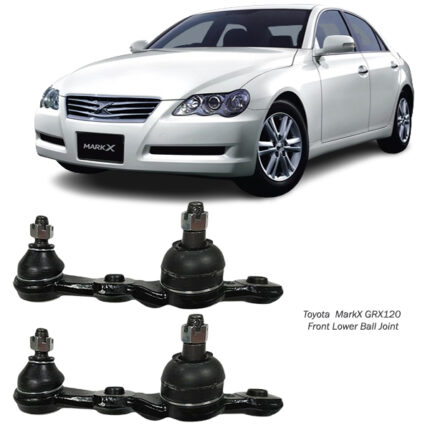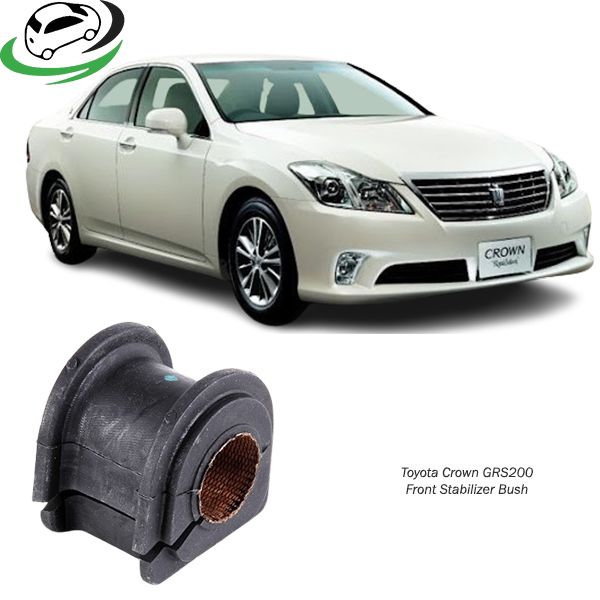-17%
Get Toyota Crown GRS200 Front Stabilizer Bush 48815-30551
The front stabilizer bush, also referred to as the sway bar bush or anti-roll bar bush, is a small but vital component in a vehicle’s suspension system. Despite its modest size and simple design, it plays an essential role in providing stability, handling, and comfort when driving. In this guide, we’ll cover the purpose, types, benefits, signs of wear, maintenance tips, replacement process, and common issues related to front stabilizer bushes.
1. Purpose and Function of the Front Stabilizer Bush
The front stabilizer bush is typically made of rubber or polyurethane and is mounted between the stabilizer bar (or sway bar) and the chassis of the vehicle. Here’s a closer look at its functions:
- Connecting the Stabilizer Bar to the Chassis: The stabilizer bar, also known as the sway bar, is a metal bar connecting the left and right suspension systems. The bush secures this bar to the vehicle’s frame, allowing it to transfer force between wheels on opposite sides of the car.
- Reducing Body Roll: When a vehicle turns or corners, centrifugal force causes one side to lift, creating what’s known as “body roll.” The stabilizer bush, together with the stabilizer bar, minimizes this by resisting the rolling motion and helping keep the car level.
- Enhancing Ride Comfort: The bush absorbs small vibrations and impacts that occur during regular driving, ensuring a smoother ride and protecting other suspension components.
In short, the stabilizer bush contributes significantly to both vehicle stability and ride comfort, making it an essential component for safe and efficient handling.
2. Types of Front Stabilizer Bushes
Front stabilizer bushes vary based on material, shape, and design. The two primary types are:
- Rubber Bushes: These are the standard bushes found in most vehicles. Rubber bushes offer excellent flexibility and cushioning, which translates into a smoother ride. However, they tend to wear out more quickly due to their softer material, especially under heavy use.
- Polyurethane (Poly) Bushes: Poly bushes are often used in high-performance or off-road vehicles because they are more durable and resistant to wear. They provide greater stiffness, enhancing the vehicle’s handling but may result in a slightly firmer ride compared to rubber bushes.
Each type has its pros and cons, with rubber bushes prioritizing comfort and poly bushes emphasizing durability and handling.
3. Benefits of Front Stabilizer Bushes
Front stabilizer bushes are crucial for the overall stability and control of a vehicle. Here are the key benefits they offer:
- Improved Handling: By reducing body roll and keeping the vehicle level, the stabilizer bush allows for sharper handling and better control during turns.
- Enhanced Safety: Stabilizer bushes improve a vehicle’s stability, particularly at higher speeds or on winding roads. This stability helps reduce the risk of rollover accidents.
- Reduced Wear on Other Suspension Parts: By absorbing shocks and reducing vibration, stabilizer bushes help extend the lifespan of other suspension components, such as ball joints and control arms.
- Quieter Ride: Worn bushes often result in clunking or rattling noises. Healthy stabilizer bushes eliminate these sounds, ensuring a quieter, more comfortable ride.
These benefits highlight the essential role stabilizer bushes play in maintaining the balance, comfort, and safety of a vehicle.
4. Signs of a Worn Front Stabilizer Bush
Over time, stabilizer bushes wear out due to constant movement, exposure to road debris, and weather conditions. Identifying early signs of wear can help prevent further damage to the suspension system. Here are common symptoms of worn stabilizer bushes:
- Clunking or Rattling Noises: When stabilizer bushes are worn or loose, you may hear clunking sounds, particularly when going over bumps or making turns. This noise is due to the metal stabilizer bar moving around and hitting other parts of the suspension.
- Increased Body Roll: If you notice more pronounced body roll when cornering, it could be due to worn stabilizer bushes failing to secure the sway bar tightly, thus reducing its ability to counteract body movement.
- Poor Steering Response: Worn bushes can cause the front suspension to feel looser, resulting in a vague or delayed steering response.
- Uneven Tire Wear: When stabilizer bushes wear out, they may put additional strain on suspension alignment, leading to uneven tire wear.
Regularly checking for these signs can help you maintain optimal handling and prevent costly repairs down the line.
5. Maintenance Tips for Front Stabilizer Bushes
Proper maintenance can extend the life of your stabilizer bushes and enhance vehicle performance. Here are some tips to ensure their longevity:
- Inspect Regularly: Check the stabilizer bushes every 10,000-15,000 kilometers or during routine servicing. Look for signs of cracking, hardening, or movement in the bush.
- Keep Them Clean: Dirt, salt, and other contaminants can contribute to faster bush degradation. Wash the suspension area periodically, especially in harsh weather conditions.
- Lubrication (If Applicable): Some polyurethane bushes require lubrication to reduce squeaking and improve performance. Check the manufacturer’s guidelines for the recommended lubricant type.
- Replace When Necessary: While rubber bushes have a limited lifespan, polyurethane bushes last longer but should still be inspected regularly. Replace worn bushes promptly to avoid further suspension damage.
6. Common Issues and Solutions
Stabilizer bushes can face specific issues over time, and understanding these can help with proper troubleshooting and replacement when needed:
- Noise from the Suspension: This is usually the first symptom of worn bushes. Replacing the worn bush or using lubricant (for poly bushes) can resolve this.
- Bush Hardening or Cracking: Rubber bushes naturally harden over time, especially in hot climates. Replacing old rubber bushes with new ones or switching to poly bushes can solve this issue.
- Rust on Brackets: Metal brackets holding the bushes can rust, reducing their ability to grip the bush tightly. Replacing rusted brackets is necessary to ensure proper fit.
Understanding these issues and their solutions can help in maintaining and prolonging the effectiveness of stabilizer bushes.
7. Replacement Process for Front Stabilizer Bushes
Replacing a front stabilizer bush is typically straightforward, but it’s recommended for those with basic mechanical knowledge or performed by a professional. Here’s a general outline:
- Lift the Vehicle: Use a jack to lift the vehicle and secure it on jack stands. Make sure the wheels are off the ground for easier access to the suspension system.
- Locate the Stabilizer Bushes: The bushes are usually found on each side of the stabilizer bar, where it mounts to the chassis.
- Remove the Mounting Brackets: Use a wrench or socket to remove the bolts securing the bush brackets to the chassis.
- Slide Out the Old Bushes: Remove the old bushes by sliding them off the stabilizer bar. Check for wear, cracking, or hardening on the old bushes.
- Install New Bushes: Place the new bushes on the stabilizer bar in the correct position. Poly bushes may require lubrication before installation.
- Reattach the Brackets: Secure the mounting brackets back onto the chassis, ensuring that the new bushes are correctly seated.
- Tighten Bolts and Test Drive: Tighten all bolts, lower the vehicle, and take it for a test drive to ensure no noise or handling issues persist.
This replacement process, when done correctly, can restore the handling and stability of your vehicle, enhancing safety and comfort.
8. Cost and Quality Considerations
The cost of replacing stabilizer bushes varies depending on the type of bush and the vehicle make and model. Rubber bushes are generally more affordable than polyurethane ones, but polyurethane bushes may last longer. It’s essential to select quality bushes from reputable brands to ensure durability and performance.
For those who regularly drive in demanding conditions or prefer enhanced handling, investing in high-quality poly bushes can be beneficial despite their slightly higher cost. However, if comfort is a priority, rubber bushes may be the preferred option.
Conclusion
Front stabilizer bushes, though small, play an indispensable role in ensuring a vehicle’s stability, handling, and comfort. By securing the stabilizer bar and reducing body roll, they contribute to a safer and smoother ride. Regular inspection, proper maintenance, and timely replacement of worn bushes are key to prolonging their lifespan and maintaining optimal vehicle performance. By understanding the function, types, benefits, and maintenance of front stabilizer bushes, you’re better equipped to keep your suspension system in excellent condition, ensuring a reliable and enjoyable driving experience.
Follow us on Facebook for more parts.



